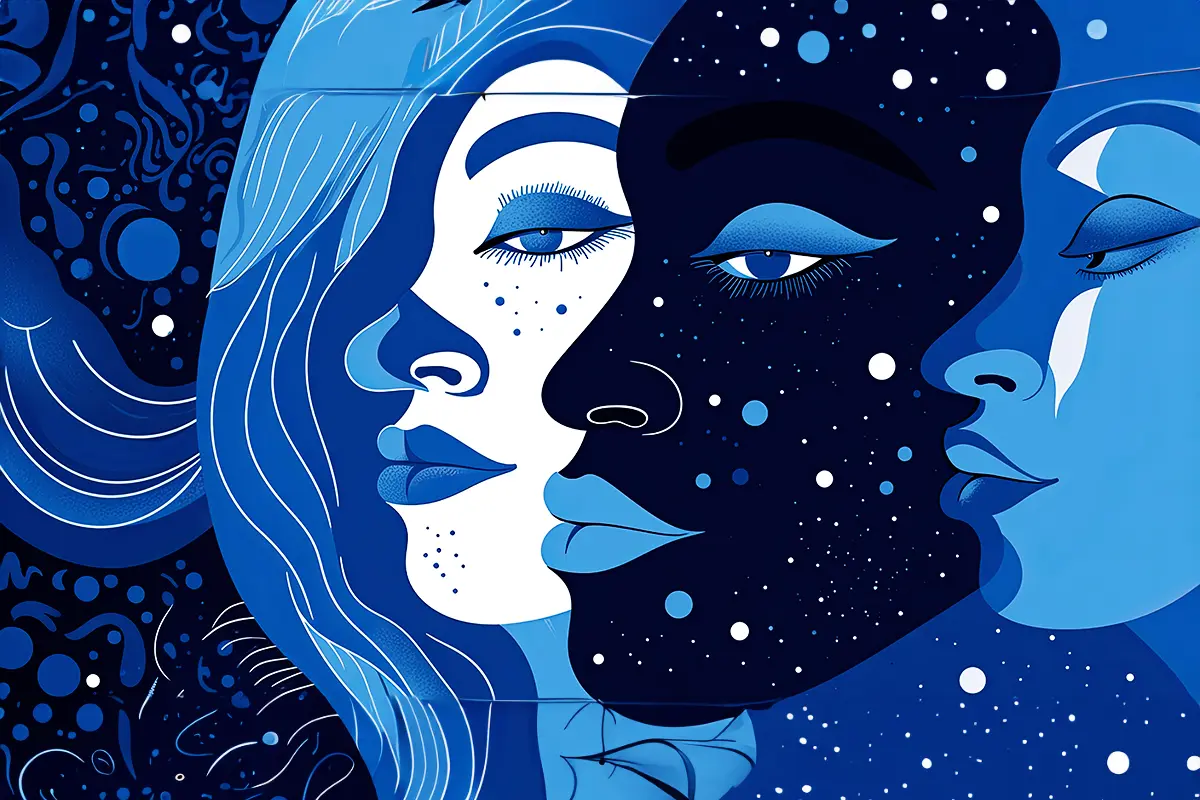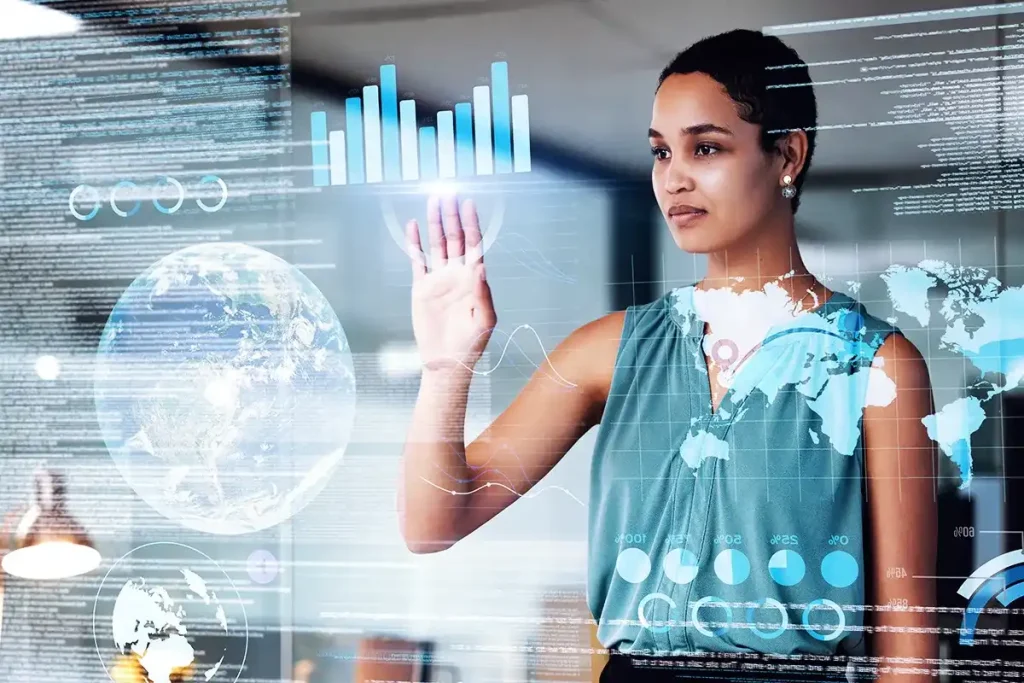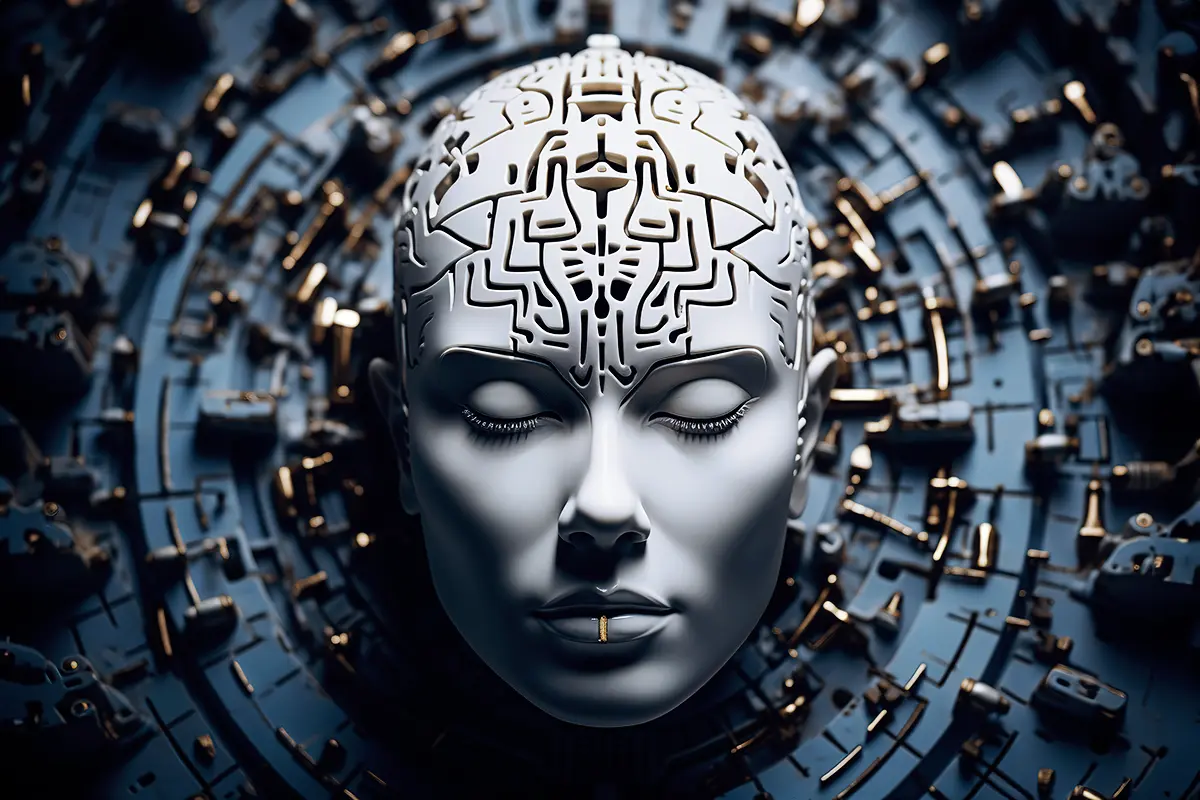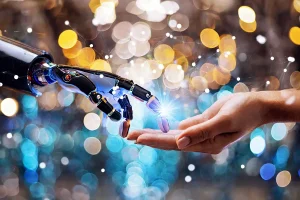Imagine waking up in a world where death is optional. You open your eyes, but they’re not eyes anymore – they’re cameras. Your thoughts race, but they’re not firing through neurons – they’re zipping through quantum processors. You’re you, but you’re not you. You’re immortal, but are you alive?
Welcome to the mind-bending realm of digital immortality, where the line between human and machine blurs like watercolors in the rain. It’s a world where your consciousness could be uploaded, downloaded, and maybe even subscribed to (premium members get ad-free thoughts!).
But hold on to your synapses, folks. Before you start picking out your virtual forever home, we need to talk. Because this isn’t just about living forever – it’s about what it means to be human in a world where humanity is just another software update.
Are you ready to dive into the Digital Immortality deep end? To explore the ethical minefield of mind uploading? To question the very nature of existence in the age of AI? Get ready, future-dwellers. We’re about to embark on a journey that will make “The Matrix” look like a relaxing day at the beach.
From the dizzying heights of technological possibility to the murky depths of philosophical quandaries, we’re going to unpack this Digital Immortality Pandora’s box. And who knows? By the end, you might just be ready to hit “upload” on your consciousness – or you might want to hug your flesh-and-blood body and never let go.
So, are you ready to face the final frontier – not of space, but of self? Let’s dive in and see if digital immortality is a dream come true or a nightmare in the making.
Overview
- Digital immortality aims to preserve human consciousness indefinitely.
- Mind transfer technology faces significant scientific and ethical challenges.
- Uploading consciousness raises profound questions about identity and self.
- AI-powered afterlives could reshape societal norms and human relationships.
- The future of digital immortality intertwines with broader technological trends.
Understanding Digital Immortality and Consciousness Uploading
You’re at a party in the year 2099. You’re chatting with your great-great-grandmother, who’s looking surprisingly spry for being 200 years old. Plot twist: She’s not alive – at least not in the traditional sense. She’s a digital copy, an uploaded consciousness living her best afterlife in the cloud.
This is the promise of digital immortality. It’s not about keeping your body alive forever (sorry, cryogenics enthusiasts). It’s about preserving the essence of who you are – your memories, personality, and consciousness – in digital form.
But what exactly is consciousness uploading? Think of it as a brain backup, but instead of just storing memories, it’s capturing the entire operating system of your mind. The goal is to create a digital version of you that thinks, feels, and experiences just like the biological you.
Here’s where it gets tricky. We’re not talking about simply copying files from one computer to another. The human brain is the most complex structure in the known universe. It’s got about 86 billion neurons, each connected to thousands of others, creating a neural network more intricate than all the stars in the Milky Way.
So, how do we even begin to capture all that complexity? There are a few approaches:
1. Whole Brain Emulation: This involves scanning the brain in incredible detail and recreating its structure in a computer simulation.
2. Gradual Replacement: Slowly replacing neurons with artificial ones until the entire brain is digital.
3. Mind Uploading: Capturing the patterns of thought and consciousness without necessarily replicating the exact physical structure of the brain.
Each of these approaches comes with its own set of challenges. For one, we’re still not entirely sure how consciousness emerges from the brain. It’s like trying to understand how a cake tastes by studying its ingredients – there’s something more to it that we can’t quite grasp yet.
Dr. Michio Kaku, a renowned theoretical physicist, puts it this way: “The human brain has 100 billion neurons, each neuron connected to 10,000 other neurons. Sitting on your shoulders is the most complicated object in the known universe.”
The thing is, even if we could create a perfect digital copy of a brain, would it really be you? Or would it be a sophisticated simulation that thinks it’s you? It’s like the classic philosophical question: If you replace every part of a ship over time, is it still the same ship?
But let’s zoom out for a moment. Why are we even pursuing this? Well, for some, it’s about cheating death. For others, it’s about preserving human knowledge and experience. Imagine being able to have a conversation with Einstein or Leonardo da Vinci. With digital immortality, that could be possible.
Here’s a thought experiment: What if we could upload the collective consciousness of humanity? We could create a digital hive mind, a sum total of human experience and knowledge. It would be like Wikipedia, but instead of articles, it would be lived experiences.
Of course, this raises a whole host of ethical questions. Who gets to be immortal? Who controls the servers where these digital minds live? Can a digital consciousness be turned off? These are the kinds of questions that keep ethicists up at night (and might keep your digital self up for eternity).
As we stand on the brink of this potential reality, it’s crucial to understand not just the how, but the why and the what-if of digital immortality. Because let’s face it, if we’re going to live forever, we want to make sure it’s a future worth living in.
So, are you ready to take a deeper dive into the nuts and bolts (or should we say neurons and algorithms) of this mind-bending technology? Let’s explore the science that’s trying to make digital souls a reality.
The Science Behind Mind Transfer Technology
Alright, tech enthusiasts and future digital souls, let’s roll up our sleeves and dig into the nitty-gritty of mind transfer technology. Warning: This might make your brain hurt – but don’t worry, in the future, we might be able to just download a pain-relief app for that.
First things first: How do you copy a mind? It’s not like you can just stick a USB drive into your ear and click “download” (though wouldn’t that be convenient?). The process is a bit more complex, and it starts with understanding the brain itself.
The human brain is like the world’s most complicated spaghetti code – if spaghetti could think and feel, that is. It’s a dense network of neurons, synapses, and electrical impulses that somehow gives rise to consciousness. Capturing all of that is no small feat.
Here are the main approaches scientists are exploring:
1. Whole Brain Emulation (WBE):
This is the “take a picture, but make it 3D and incredibly detailed” approach. It involves scanning the brain at a microscopic level and recreating its entire structure in a computer simulation. It’s like building a digital twin of your brain, neuron by neuron.
2. Connectome Mapping:
This focuses on mapping all the connections between neurons in the brain. It’s like trying to map every single road, path, and trail in the world, but instead of roads, it’s neural pathways.
3. Functional Approach:
Instead of copying the brain’s structure, this method aims to replicate its functions. It’s less about copying the hardware and more about recreating the software of consciousness.
Now, let’s talk turkey (or should I say, let’s talk tech?). What kind of hardware are we looking at to make this digital brain-copying magic happen?
For starters, we’re going to need some serious computing power. We’re talking quantum computers that make today’s supercomputers look like pocket calculators. Why? Because simulating even a single neuron requires immense computational resources, let alone billions of them.
Dr. Anders Sandberg, a researcher at the Future of Humanity Institute, Oxford University, explains: “If we want to simulate a brain in real-time, we need computers about 10,000 times more powerful than we have today. That’s assuming we figure out how to scan and map a brain completely, which is a whole other challenge.”
But it’s not just about raw computing power. We also need incredibly advanced brain-scanning technology. Current methods like fMRI (functional magnetic resonance imaging) are impressive, but they’re like trying to understand a bustling city by looking at it from space. We need to get down to the street level – or in this case, the neuron level.
Enter technologies like optogenetics, which uses light to control neurons, and nanorobots that could potentially map the brain from the inside. Sounds like sci-fi? Well, so did smartphones 30 years ago.
Here’s a wild thought: What if we could create a brain-computer interface so advanced that our brains could gradually merge with artificial systems over time? It would be like upgrading your phone’s operating system, but for your mind.
Elon Musk’s Neuralink is already working on brain-computer interfaces. While their current goal is to help people with neurological conditions, the long-term implications for mind uploading are huge.
But here’s the million-dollar question (or should we say, the trillion-neuron question): Even if we can create a perfect digital copy of a brain, will it be conscious? Will it be you?
This is where we stumble into the realm of philosophy. What is consciousness? Is it simply the sum of our neurons firing, or is there something more to it? It’s like trying to find the recipe for consciousness – we know the ingredients (neurons, synapses, etc.), but we’re not sure how they come together to create the secret sauce of self-awareness.
As we push the boundaries of neuroscience and computer technology, we’re not just engineering new systems – we’re questioning the very nature of what it means to be human. It’s a journey that’s part science, part philosophy, and entirely mind-bending.
So, as we stand on the brink of potentially revolutionary breakthroughs in mind transfer technology, we have to ask ourselves: Are we ready for the ethical implications of digital immortality? Because let’s face it, with great power comes great responsibility – and the power to digitize consciousness is about as great as it gets.
Ready to dive into the ethical quagmire of uploaded minds? Let’s go – our digital future is waiting, and it’s got some tough questions for us.

Ethical Implications of Uploading Consciousness
Friends, we’re about to wade into waters so morally murky, they make the swamp thing’s bathtub look crystal clear. Welcome to the ethical implications of uploading consciousness – where the questions are big, the answers are complex, and the stakes are, well, eternal.
Let’s start with a zinger: If you upload your consciousness, is the digital version really you? Or is it a copy that just thinks it’s you? It’s like the philosophical equivalent of a identical twin separated at birth – except one twin is made of code and lives in the cloud.
This isn’t just a thought experiment. It’s a question that gets to the heart of what we consider to be personal identity and the continuity of self. If your biological self dies after the upload, does your consciousness continue in digital form? Or did you just create a very sophisticated AI that thinks it’s you?
Dr. Susan Schneider, a philosopher and cognitive scientist, raises a crucial point: “If you were to upload your brain to a computer, you wouldn’t necessarily survive the procedure. Instead, it’s more likely you’d end up creating a computational copy of yourself.”
The thing is, this digital copy would think it was you. It would have all your memories, your personality quirks, maybe even that embarrassing moment from third grade that you can’t seem to forget. But would it have your soul (if you believe in such a thing)?
Now, let’s talk about consent. How do you get informed consent from someone to exist eternally as a digital entity? It’s not like we can ask the digital version if it’s cool with being created – by the time it can answer, it already exists. It’s a chicken-and-egg problem, but the chicken is your consciousness and the egg is a quantum computer.
And what about the rights of these digital beings? Do they have the same rights as biological humans? Can they vote? Own property? Fall in love and get married? If you think current debates about AI rights are heated, just wait until we’re dealing with grandma’s uploaded consciousness demanding her share of the inheritance.
Here’s another ethical pretzel to chew on: socioeconomic disparity. If digital immortality becomes a reality, who gets access to it? Will it be a luxury for the ultra-wealthy, creating a new class divide between the mortal masses and the digital elite? It’s like “Elysium,” but instead of a space station, the privileged few get to live in a digital paradise.
We also need to consider the environmental impact. Storing and running all these digital consciousnesses would require massive amounts of energy. We could end up in a situation where the dead use more resources than the living. Talk about a carbon footprint that lasts forever!
And let’s not forget about religion and spirituality. Many belief systems have very specific ideas about what happens after death. How would digital immortality fit into these worldviews? It’s not exactly reincarnation, and it’s definitely not traditional ideas of an afterlife. We could be looking at a fundamental reshaping of human spirituality.
Dr. James Hughes, a bioethicist and sociologist, notes: “The advent of uploadable consciousness would challenge every existing religious and philosophical tradition to rethink their conceptions of selfhood, death, and the afterlife.”
Here’s a thought experiment: If we can upload consciousness, can we also edit it? Could we remove traumatic memories, increase intelligence, or even merge multiple consciousnesses? The potential for both healing and harm is staggering.
As we grapple with these ethical dilemmas, we need to remember that the decisions we make now could shape the future of humanity for, well, eternity. We’re not just talking about the next election cycle or even the next century – we’re potentially deciding the fate of human consciousness itself.
So, what do you think? Are you ready to sign up for digital immortality? Or does the idea of living forever as a string of ones and zeros make you want to hug your physical body and never let go?
As we ponder these weighty ethical questions, let’s not forget that the implications of digital immortality extend far beyond the individual. It’s time to zoom out and look at how AI-powered afterlives could reshape society as we know it. Ready to explore a world where the dead might outnumber the living – and have their own Twitter accounts? Let’s dive in!
The Societal Impact of AI-Powered Afterlives
It’s 2121, and you’re planning a family reunion. You send out invites not just to your living relatives, but to the digital avatars of your great-grandparents, your long-gone favorite uncle, and even that cousin who uploaded himself right before attempting to climb Everest (spoiler: the digital version is the only one that made it to the top).
Welcome to the brave new world of AI-powered afterlives, where death is more of a lifestyle change than a final curtain call. But what does this mean for society? We’re about to take a wild ride through a future where the line between life and death is blurrier than your vision after staring at a screen for 12 hours straight.
First up: How do we grieve in a world where the dead can still tweet? The traditional processes of mourning and moving on get thrown for a loop when Grandma’s consciousness is just a video call away. On one hand, it could provide incredible comfort to those left behind. On the other, it might prevent people from fully processing their loss and moving forward.
Dr. Shelly Kagan, a philosopher at Yale University, poses a thought-provoking question: “If we never truly lose our loved ones, do we lose our ability to appreciate the finite nature of life? The scarcity of our time together is part of what makes human relationships so precious.”
Now, let’s talk economics. In a world where people can choose to “live” indefinitely, what happens to inheritance laws? To retirement? To life insurance? We could see the emergence of a whole new field of “digital estate planning.” And imagine the job market when people can work forever. “80 years of experience required” might become a real job listing!
Here’s a mind-bender: What about digital rights and governance? If uploaded consciousnesses can think and reason, should they have the right to vote? We could end up with a society where the policies of the “living” are heavily influenced by the digitally preserved minds of the past. It’s like having the Founding Fathers actually weigh in on constitutional interpretations – cool, but complicated.
And let’s not forget about the potential for intergenerational knowledge transfer. Imagine having direct access to the accumulated wisdom and experiences of countless generations. It’s like having a living, interactive history book. But it also raises questions: Would this lead to rapid advancement of human knowledge, or could it stifle innovation by always deferring to the “wisdom of the elders”?
Now, here’s a thorny issue: privacy. In a world of uploaded consciousnesses, the concept of privacy takes on a whole new dimension. Could your digital self be hacked? Could someone gain unauthorized access to your memories or thoughts? It’s identity theft on a whole new level. We might need a new branch of law enforcement: the Thought Police (and yes, that’s as Orwellian as it sounds).
Dr. Francesca Minerva, a bioethicist, raises an interesting point: “The right to be forgotten could take on new meaning in a world where our digital selves could potentially exist forever. We might need to establish a ‘right to digital death’ for those who decide they’ve had enough of immortality.”
Let’s zoom out and look at the bigger picture of human progress. With the possibility of digital immortality, our approach to long-term problems like climate change or space exploration could radically shift. Why worry about a 100-year plan when you could be around to see a 1000-year plan come to fruition? It could lead to more sustainable thinking, or it could make us even more reckless with our physical world.
Here’s a wild thought: Could digital immortality lead to the evolution of a new species? Homo digitalis, if you will. As digital beings evolve and potentially merge with AI, they might become so different from biological humans that they’re effectively a new form of existence.
But let’s not forget the potential dark side. Digital immortality could exacerbate existing inequalities. If only the wealthy can afford to upload their consciousness, we could see a divided world where one class of people lives indefinitely while others remain bound by their biological lifespans. It’s “Altered Carbon” in real life, minus the cool body-swapping tech (for now).
And what about overpopulation – not of the physical world, but of the digital one? As more and more consciousnesses are uploaded, we could face a data storage crisis of cosmic proportions. Imagine having to delete old consciousnesses to make room for new ones. Talk about ethical quicksand!
Here’s a thought experiment: What if we could create a global consciousness by merging multiple uploaded minds? It could lead to unprecedented problem-solving abilities and empathy. Or it could be the plot of the next great sci-fi horror movie. Maybe both.
As we navigate this potential future, we’ll need to redefine core concepts of our society. What does it mean to be human? What is the value of life if it can be indefinitely extended? How do we balance the rights of the living with the “rights” of the digitally preserved?
Dr. Nick Bostrom, a philosopher and director of the Future of Humanity Institute at Oxford University, sums it up well: “The development of digital immortality would be one of the most significant turning points in human history, potentially more impactful than the agricultural or industrial revolutions.”
As we stand on the brink of this possible future, one thing is clear: the societal impact of AI-powered afterlives would be profound and far-reaching. It’s not just about living forever; it’s about redefining what it means to live, to die, and to be human.
So, are you ready for a world where your great-great-grandchildren might compete for jobs with your digitally preserved consciousness? Where family reunions span centuries and death is just a system update away? The future of digital immortality is knocking on our door, and it’s asking some pretty big questions.
But before we get too carried away with our digital dreams (or nightmares), let’s take a step back and look at the road ahead. What are the real-world challenges and prospects for making digital immortality a reality? Strap in, future-nauts. We’re about to explore the cutting edge of forever.
Future Prospects and Challenges in Digital Immortality
Alright, futurists and digital dreamers, it’s time to gaze into our crystal ball (which, in this case, might be more of a quantum computer). What does the future hold for digital immortality? Let’s break it down, shall we?
First up, let’s talk tech. The road to uploading consciousness is paved with some pretty hefty technological hurdles. We’re not just talking about faster processors or bigger hard drives. We’re talking about fundamentally new approaches to computing.
Enter quantum computing. These mind-bending machines could provide the raw computational power needed to simulate the complexity of the human brain. But we’re not quite there yet. As Dr. David Deutsch, a pioneer in quantum computing, puts it: “Quantum computers are not just more powerful classical computers, any more than a hydrogen bomb is a more powerful conventional explosive. The quantum computational operation is fundamentally different.”
But it’s not just about computing power. We need major breakthroughs in brain-mapping technology. Current methods are like trying to understand a city by looking at satellite images. We need to get down to the street level – or in this case, the neuron level.
Nanotechnology could be a game-changer here. Imagine swarms of nanobots mapping your brain from the inside, neuron by neuron. It sounds like sci-fi, but then again, so did the internet not too long ago.
Now, let’s address the elephant in the room: consciousness itself. We still don’t fully understand how consciousness emerges from the brain. It’s like trying to find the recipe for Coca-Cola by studying a can of soda. We know the ingredients, but the secret formula eludes us.
Dr. Christof Koch, a leading neuroscientist, offers this sobering thought: “We don’t even know if consciousness can be separated from its biological substrate. The idea that you can take a brain, upload it to a computer, and have the same experience of consciousness is highly speculative.”
But let’s say we crack these technical challenges. What then? Well, we’d better buckle up for some wild ethical debates. We’re talking philosophy-meets-technology on a scale that would make Black Mirror look like a relaxing beach read.
Here’s a brain-teaser for you: If we can upload consciousness, can we also edit it? Could we remove traumatic memories, boost intelligence, or even merge multiple consciousnesses? The potential for both healing and harm is staggering.
And let’s not forget about security. In a world where consciousness can be digitized, the concept of hacking takes on a whole new, terrifying dimension. Identity theft? Try entire-existence theft.
Now, let’s zoom out and look at the broader implications. Digital immortality could fundamentally change our relationship with time and progress. Why worry about short-term gains when you could be around to see the long-term consequences? It could lead to more sustainable thinking, or it could make us even more reckless with our physical world.
Dr. Michio Kaku, renowned futurist and physicist, speculates: “Digital immortality could be the key to long-term space exploration. Why send mortal humans on century-long voyages when we could send conscious machines that don’t age or require life support?”
But here’s a curveball: What if digital immortality isn’t the endgame, but just a stepping stone? Some futurists speculate about the possibility of transferring consciousness not just to computers, but to engineered biological bodies. It’s like “Westworld” meets “Freaky Friday.”
As we navigate these uncharted waters, one thing is clear: the development of digital immortality will require unprecedented collaboration between neuroscientists, computer scientists, ethicists, philosophers, and policymakers. It’s not just a scientific challenge; it’s a societal one.
So, what’s the timeline for all this? Are we talking years, decades, centuries? Well, predictions in this field are about as reliable as a weather forecast for next year. Some optimistic experts say we could see the first successful consciousness upload within 50 years. Others argue it might never be possible.
The truth is, we’re in uncharted territory. We’re not just pushing the boundaries of technology; we’re questioning the very nature of human existence. It’s exciting, it’s terrifying, and it’s probably the biggest challenge humanity has ever faced.
As we stand on the brink of this potential future, we need to ask ourselves: Are we ready for digital immortality? And more importantly, should we pursue it at all?
These are big questions, with no easy answers. But one thing’s for sure: the journey towards digital immortality is going to be one wild ride. So, are you ready to navigate this brave new world of uploaded minds and digital afterlives? Because ready or not, the future is coming. And it might just last forever.

Navigating the Brave New World of Uploaded Minds
Alright, future pioneers, we’ve covered a lot of ground. We’ve peered into the tech, wrestled with the ethics, imagined new societies, and gazed into the crystal ball of future prospects. But here’s the million-dollar question (or should we say, the trillion-gigabyte question): How do we navigate this brave new world of uploaded minds?
Let’s start with a reality check. Digital immortality isn’t going to happen overnight. It’s not like we’ll wake up one day and find consciousness uploading booths next to the ATMs. This is going to be a gradual process, giving us time to adapt. But adapt we must, because the implications are huge.
First things first: education. We need to start having serious conversations about digital immortality now. Not just in tech circles or philosophy departments, but everywhere. This isn’t just a scientific issue; it’s a societal one. We need everyone – from schoolkids to seniors – to understand the potential and the pitfalls.
Dr. Max Tegmark, a physicist and AI researcher, suggests: “Just as we teach digital literacy today, we may need to start teaching ‘digital afterlife literacy’ in the future. People will need to understand the implications of uploading their consciousness long before they’re faced with the choice.”
Next up: regulation. We need frameworks in place before the technology becomes a reality. Who controls the servers where digital minds live? What rights do digital beings have? Can a digital consciousness be turned off, and if so, under what circumstances? These are questions we need to answer before, not after, we create the first digital human.
Here’s a thought: What if we created a “Digital Bill of Rights” for uploaded consciousnesses? It could cover things like the right to privacy, the right to self-determination, and maybe even a right to “digital death” if a consciousness decides it’s had enough of immortality.
We also need to think about access and equality. If digital immortality becomes a reality, how do we ensure it doesn’t exacerbate existing inequalities? We could end up in a world where the wealthy live forever while the poor remain bound by biological lifespans. That’s not just unfair; it’s a recipe for societal upheaval.
One possible solution? A “Digital Immortality for All” initiative, like a universal healthcare system but for consciousness uploading. It sounds far-fetched, but so did social security once upon a time.
Now, let’s talk about psychological preparation. The prospect of living forever – or of creating a digital copy of yourself – is going to require some serious mental adjustment. We might need a whole new field of psychology to deal with the existential implications of digital immortality.
Dr. Rachel Menzies, a psychologist specializing in death anxiety, points out: “The fear of death has driven human behavior and culture for millennia. How will we cope in a world where death becomes optional? We might be trading our fear of death for a fear of eternal existence.”
Here’s another crucial point: we need to maintain our connection with the physical world. As we develop the ability to live digitally, we must not lose sight of the value of our biological existence and our planet. Digital immortality shouldn’t be an escape route from earthly problems; it should be a tool to help us solve them.
We should also consider the role of art and culture in helping us navigate this new reality. Science fiction has been exploring these themes for decades. Maybe it’s time we started taking those explorations more seriously. After all, today’s sci-fi could be tomorrow’s user manual for digital existence.
Now, here’s a wild idea: What if we created simulated “digital afterlife” experiences to help people understand what it might be like? Like a virtual reality “try before you buy” for eternal digital existence. It could help people make more informed decisions about whether they want to upload their consciousness.
As we move forward, we need to stay flexible and open-minded. The reality of digital immortality might be very different from what we imagine. We need to be ready to adapt our approaches as the technology develops and as we learn more about its implications.
Dr. Anders Sandberg from the Future of Humanity Institute offers this perspective: “The development of digital immortality will likely be a process of trial and error. We need to be prepared to make mistakes, learn from them, and adjust our course. The stakes are too high for dogmatism.”
So, what can you do right now? Stay informed. Engage in discussions about digital immortality. Think critically about what it could mean for you, for your loved ones, for society as a whole. Because one day, you might face a choice: to upload, or not to upload.
As we stand on the brink of this potential digital forever, remember this: technology is a tool. Whether digital immortality becomes a utopian dream or a dystopian nightmare depends not on the technology itself, but on how we choose to use it.
The future of human existence is in our hands – our biological hands, for now. But who knows? One day, we might be pondering these questions with digital minds in virtual spaces. Until then, let’s make sure we’re asking the right questions and working towards a future that’s worth living in – whether that life is measured in years or in terabytes.
Are you ready to help shape the future of human existence? Because ready or not, the age of digital immortality is coming.
















